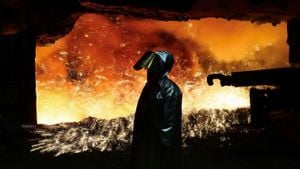Scientists have recently unwrapped exciting new evidence pointing to the Moon's ancient origins. A magma ocean may have once spread across its surface, according to findings from India’s latest lunar venture, the Chandrayaan-3 mission.
Launched last year, the mission featured the Vikram lander and its rover, Pragyan, which landed on the lunar south pole, historically one of the least explored lunar regions. The data collected there has now provided insights about the Moon's primordial state, supporting the idea it once had a molten environment.
The study, published on August 21, 2024, in the journal Nature, shows the analysis of lunar soil revealed compositions consistent with ferroan anorthosite, a rock type believed to originate from early magma oceans. This rock’s uniform presence across various sites around the landing area points to the Moon's surface having formed from crystallized magma.
Ferroan anorthosite is key to the Lunar Magma Ocean (LMO) hypothesis, which suggests the Moon formed from debris created by the colossal impact of another planet. The scientific consensus has long held this hypothesis, but now, new explorations reinforce its validity.
Anil Bhardwaj, director of the Physical Research Laboratory and co-author of the study, stressed how unique the landing site was. "The composition of lunar soil found near the south pole was historically overlooked, yet it holds substantial clues to the Moon's formation and evolution,” he explained.
The Chandrayaan-3 mission utilized advanced technologies, including instruments like the Alpha Particle X-Ray Spectrometer (APXS), which allowed for detailed measurements of surface materials. Within just ten days post-landing, the Pragyan rover made extensive analyses, studying the soil composition and lending credence to theories developed over decades.
This new analysis stands alongside rock samples obtained from the Apollo missions, showcasing surprising similarities between the compositions found at different lunar locations. According to Bhardwaj, the uniformity of these measurements across high-latitude regions suggests the Moon was once entirely covered by this deep magma ocean.
Prior lunar missions focused largely on equatorial regions; hence, data from the high-latitude south pole were previously sparse—a gap now filled with these significant new findings. The constancy of rock types validated by they mention of 23 measurements emphasizes the geological connections within the Moon's shell.
The recent discovery also bridges gaps left by earlier missions, particularly NASA's Apollo program and the Soviet Luna missions. The data compiled from these various missions reveal significant scientific continuity.
Both Bhardwaj and Santosh Vadawale, the study’s lead author, emphasized the broader impact of these findings on future lunar exploration endeavors. Understanding the Moon's formation helps contextualize the history of not just our neighbor but also other terrestrial planets.
This research is particularly intriguing to scientists because magma oceans typically occur during the formation stages of terrestrial planets. It is also valuable for predicting future conditions for potential lunar habitation, especially concerning the south pole region, which likely holds valuable water ice.
Indeed, the Moon’s south pole is of immense interest to agencies like NASA and China’s space program. The potential presence of water ice tantalizes plans for future lunar bases and sustainable missions deep within our solar system.
Such aspirations gained momentum post-Chandrayaan-3, especially since the mission successfully navigated the perilous descent and established its scientific foothold, proving India's burgeoning capabilities within space exploration. The mission underlines how modern nations are stepping forward to unravel the Moon's mysteries and claim their stake within this cosmic frontier.
After the mission's success, plans for subsequent explorations have ignited discussions about what lies beneath the lunar surface. The focus is now shifting to permanently shadowed regions at the poles, where scientists believe water and possibly other resources are stored, waiting to be discovered.
Vadawale reflects on the significance of their findings, stating, "Our next mission will target these frozen regions, focusing on how to extract potential water resources necessary for future lunar expeditions.”
With their major advancements, researchers are now calling for more attention to future lunar missions. The scientific community recognizes the flourishing interest and momentum for return missions to the Moon.
Through building upon historical studies and improving data access, these organizations can continue to bolster their lunar exploration initiatives. Insightful data collected by the Pragyan rover may lay the groundwork for monitoring changes, distinguishing rock types, and significantly eleviating our overall comprehension of the Moon.
The Moon's allure continues, with its surface long awaiting thorough exploration beyond what we previously understood. Collectively, these new findings blend with the Moon's rich history, clarifying how it may eventually support future capabilities both on and off Earth.
Continuing interest around achievements stemming from the Chandrayaan-3 mission reaffirms the belief: the Moon holds many secrets yet to reveal, contributing to our broader cosmic narrative. For nations engaged deeply within space endeavors, the quest for knowledge presents limitless possibilities on both personal and scientific fronts.
Future missions will have the opportunity to follow paths carved by earlier teams, bridging the historical gap once dominated by superpower endeavors. Now, the stage is set for global explorers to transform the Moon's potential exploration roles for years to come.
The emergence of data about the ancient magma ocean brings fresh impetus to future missions. The scientific community has extra motivation to expand knowledge and collaboration across borders—because, when it boils down to it, no single nation holds all the keys to the secrets of the cosmos.



